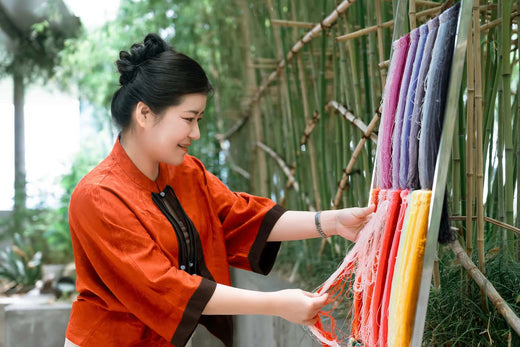Quilts are more than just cosy blankets; they're works of art created with passion and skill. In this article, we'll take you on a journey through the fascinating world of crafting silk quilts. From the types of silk used to the diverse quilt designs and patterns, you'll get an exclusive behind-the-scenes look at the artistry of silk quilt making.
The Choice of Silk
The foundation of a silk quilt is, of course, the silk itself. There are different types of silk used in quilt making:
- Mulberry Silk: Known for its supreme softness, mulberry silk is a top choice. Silkworms fed exclusively on mulberry leaves produce this luxurious material.
- Tussah Silk: Slightly coarser in texture, tussah silk comes from wild silkworms and can create a more rustic look.
- Eri Silk: Also called "peace silk," eri silk is cruelty-free as it allows the silkworms to emerge from their cocoons. It has a unique texture and is an ethical choice.
Quilt Design and Patterns
Silk quilt designs come in a wide array of patterns, each telling a unique story. Here are some popular ones:
- Patchwork Quilts: These quilts are a patchwork of smaller silk fabric pieces stitched together. The combinations are endless, allowing for creative and colourful designs.
- Appliqué Quilts: In appliqué quilts, silk shapes are sewn onto a solid silk background to create intricate patterns and pictures.
- Embroidered Quilts: Silk quilts may feature delicate silk embroidery, adding an extra layer of artistry to the piece.
- Kantha Quilts: Originating in India, Kantha quilts are made by layering and stitching together multiple silk fabrics. They often feature beautiful, bold patterns.
The Quilting Process
The quilting process itself is a labour of love. It involves layering the silk top with batting (the filling) and a backing fabric, then sewing them together to create a "quilt sandwich." This is usually done by hand or with a sewing machine, depending on the intricacy of the design.
The Finishing Touches
To finish a silk quilt, it's important to bind the edges neatly to secure all the layers. This not only provides a polished look but also ensures the quilt's longevity. Some quilters also add decorative elements, such as piping or ruffles, to enhance the visual appeal.
A Work of Art
Silk quilts aren't just bedding; they're true works of art. Crafted with precision, care, and creativity, they represent the dedication of the artisans who bring them to life. Whether displayed as wall hangings or draped over your bed, silk quilts are not only practical but also pieces of art that tell a story of tradition, culture, and craftsmanship.
The art of crafting silk quilts is a remarkable journey from the choice of silk to the final, exquisite creation. Each step in the process requires skill and a keen eye for design. The result is not just a cosy cover but a masterpiece that adds elegance and cultural richness to any space. The next time you wrap yourself in a silk quilt, you'll know that you're enveloped in a piece of artistry, warmth, and tradition.
Related Content:
Chinese Silk: A Tale of Tradition and Craftsmanship
Choosing the Perfect Silk Bedsheet: A Buyer's Guide
Silk Quilts vs. Traditional Quilts: Unravelling the Differences
The Elegance of Silk Bedsheets: A Guide to Luxurious Sleep

